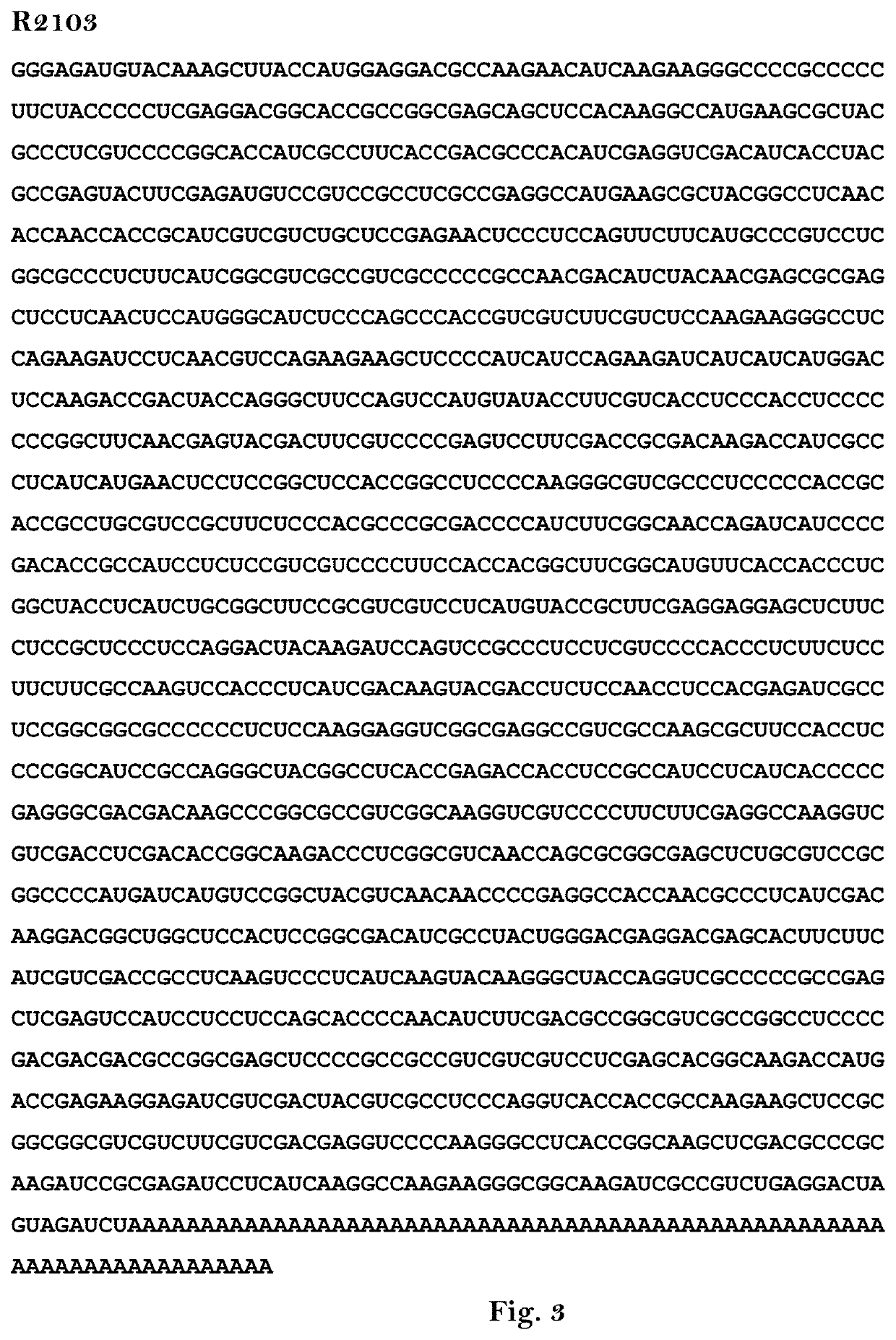Modified RNA with decreased immunostimulatory properties
a technology of immunostimulatory properties and modified nucleosides, which is applied in the direction of animal/human proteins, genetic material ingredients, peptides/proteins, etc., can solve the problems of less desired approach to reduce innate immune stimulation based on mrna containing non-natural modified nucleosides, unsatisfactory complications, and potential immunostimulating properties of mrna that may not be suitable for therapy, so as to reduce the innate immune response level level
- Summary
- Abstract
- Description
- Claims
- Application Information
AI Technical Summary
Benefits of technology
Problems solved by technology
Method used
Image
Examples
example 1
on of mRNA
Preparation of DNA and mRNA Constructs
[0207]For the present examples DNA sequences encoding the Photinus pyralis luciferase were prepared and used for subsequent in vitro transcription reactions.
[0208]According to a first preparation, the DNA sequences coding for the mRNAs shown in Table 1 were prepared.
[0209]The G / C-enriched sequences of the examples provided were obtained according to the method as disclosed in WO2002098443 A2. The C-enriched modified mRNA coding region was obtained by the method of the present invention. However, alternatively, the C-enriched mRNA of the examples included may also be obtained according to the alternative embodiment as disclosed above, i.e. in a first step, the G / C content may be increased, e.g. by substituting wild type codons exhibiting a lower content of G and C nucleotides as disclosed in WO2002098443 A2. As a second step the G / C-enrichment or maximization is followed by a step of further C-optimization.
[0210]A vector for in vitro tr...
example 2
mulation of Peripheral Blood Mononuclear Cells (PBMCs) Treated with Modified mRNAs
Preparation of Human PBMCs
[0220]25 ml of a buffy coat were layered over 20 ml of Ficoll in a 50 ml Falcon tube. After centrifugation at 805 relative centrifugal force (rcf) for 20 minutes, cells at the interphase were collected. Cells were washed two times by resuspending in PBS and centrifuging. After counting, cells were resuspended at 50 million cells per ml in fetal calf serum, 10% DMSO, and frozen.
PBMC Stimulation
[0221]Human PBMCs were seeded at a density of 106 cells / ml into each well of a 96-well plate (2×105 cells / well) in X-Vivo 15 medium (Lonza) and treated with 10 μg / ml of GC- or C-enriched mRNA for 20 hours and the TNFα concentration was determined in the supernatant by ELISA.
Cytokine ELISA (TNFα)
[0222]96 well ELISA plates were coated with capture antibody (BD Pharmingen) in coating buffer (15 mM Na2CO3, 15 mM NaHCO3, 0.02% NaN3, pH 9.6) over night at room temperature. Plates were blocked w...
example 3
onse Relationship for Immunostimulation of PBMCs Treated with Modified mRNAs
PBMC Stimulation
[0227]Human PBMCs were prepared as described in Example 2. PBMCs were seeded at a density of 106 cells / ml into each well of a 96-well plate (2×105 cells / well) in X-Vivo 15 medium (Lonza) and treated with 40 or 20 μg / ml of GC- or C-enriched mRNAs as indicated for 20 hours. The TNFα and IFNα concentrations were determined in the supernatant by ELISA.
Cytokine ELISA
[0228]The TNFα ELISA was performed as described in Example 2. The IFNα ELISA was performed analogously, replacing the capture and detection antibodies appropriately (Mabtech).
Results
[0229]FIG. 10 shows the dose-response relationship for TNFα secretion of human PBMCs treated with various modified mRNAs. As can be seen the treatment with C-enriched mRNA results in less TNFα secretion than with GC-enriched mRNA.
[0230]FIG. 11 shows the dose-response relationship for IFN□ secretion of human PBMCs treated with various modified mRNAs. As can ...
PUM
| Property | Measurement | Unit |
|---|---|---|
| concentration | aaaaa | aaaaa |
| concentrations | aaaaa | aaaaa |
| concentrations | aaaaa | aaaaa |
Abstract
Description
Claims
Application Information
 Login to View More
Login to View More - R&D
- Intellectual Property
- Life Sciences
- Materials
- Tech Scout
- Unparalleled Data Quality
- Higher Quality Content
- 60% Fewer Hallucinations
Browse by: Latest US Patents, China's latest patents, Technical Efficacy Thesaurus, Application Domain, Technology Topic, Popular Technical Reports.
© 2025 PatSnap. All rights reserved.Legal|Privacy policy|Modern Slavery Act Transparency Statement|Sitemap|About US| Contact US: help@patsnap.com



